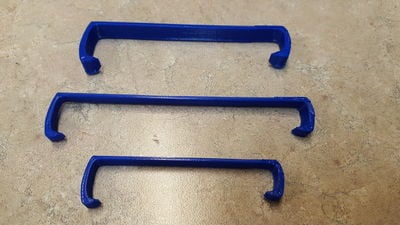Surgical Retractor Set
Project developed by Chrissy Kaub
Template:Statusboxtop Template:Status-design Template:Status-prototype You can help Appropedia by contributing to the next step in this OSAT's status. Template:Boxbottom
Abstract
- Paragraph description of the OSAT - why is it Appropriate? What need does it fulfil? Are there case studies you have found of a technology being used successfully?
- In many developing nations, there is a constant demand for medical supplies, which are not only sometimes small in quantity but are often hard to transport to small, isolated communities in remote areas.
- A lot of donated materials through humanitarian organizations consist of small-scale medical supplies that are frequently used in pediatrics and general care, however surgical equipment is is far and in-between. As a result many surgeries are performed with single-use and outdated equipment past their expiration date, which as a result can not only become a large biohazard to the patient, but risk breakage during use.
- One of the for 3-D printable open source appropriate technology requests was for single-use surgical retractors. The retractors were designed to help pull open wounds or surgical openings for operations, while being modular for operator usage. Not only can they be quickly printed, but one end is ergonomically fitted for a gloved finger to pull without slippage. This design improvement was critical, as many surgical retractors have small edges which are hard to get a grasp on when wearing nitrile gloves. Many surgeons combat this by holding them like a pencil, but these can be also pulled with a single finger for not only ease of use, but allows them to keep their hands out of their range of vision during delicate procedures.
https://www.ncbi.nlm.nih.gov/pubmed/24721602
Bill of Materials
- Provide a full BOM -- Materials needed for fabrication of device and alternative materials if they are not available, prices/sources of non-printable parts
- Upload and link to all source files from open source CAD
- Upload and link to all STLs
Tools needed for fabrication of the OSAT
- MOST Delta RepRap or similar RepRap 3-D printer
Skills and Knowledge Necessary to Make the OSAT
- If you used special skill – link to relevant wikipedia or wikiversity articles/courses
Technical Specifications and Assembly Instructions
- Provide directions for print/assembly - be detailed enough in your “how to” to ensure that someone could construct the device from your description. Consider the elegance of IKEA like instructions.
- Include print time estimate
- Include assembly time estimate
- Including drawings or pictures of the device at stage of assembly at minimum. (http://www.appropedia.org/Special:Upload)
- Consider video if appropriate
| Example video summary of textbook |
|---|
Error in widget YouTube: Unable to load template 'wiki:YouTube' |
Common Problems and Solutions
- Include common mistakes/problems to avoid in building your OSAT and how to overcome them
Cost savings
- If your solution is not a low cost one then it is not really appropriate.
- Estimate your costs
- Find a commercial equivalent
- Calculate $ savings and % savings
References
- The sources of information (e.g. engineering handbooks, journal articles, government documents, webpages, books, magazine articles etc.). References should use the <ref> </ref> and <references/> tags and can be in any format but should include all the information necessary for someone else to find the same information you did. For example: [1]
- ↑ web page: Department of Energy (DOE) Landscaping and Energy Efficiency, DOE/GO-10095 (1995) Available: http://www.eren.doe.gov/erec/factsheets/landscape.html
Based on the developmental needs addressed (e.g. food, heat, electricity, clean water, health care, etc.) be sure to label your device in the proper categories e.g. use [[Category:Water]]. Be sure to categorize your device so that it will be easy to find – for example “Low voltage connection basics” is categorized in [[Category:How tos]] [[Category:Electricity]] [[Category:Electric lighting]].
